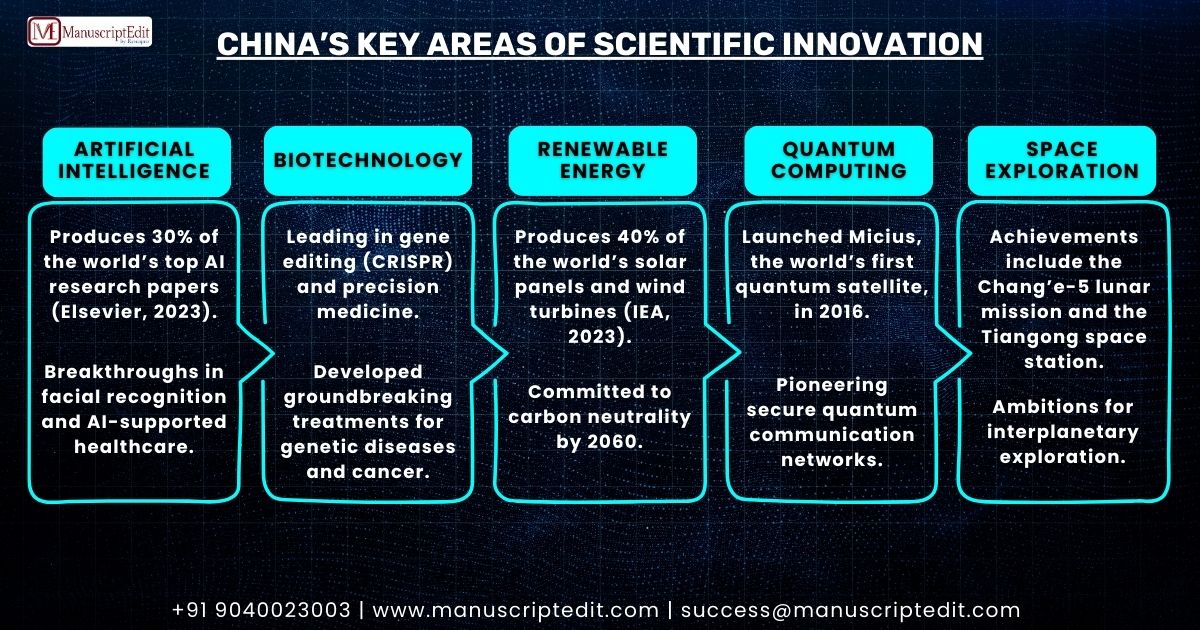
Do you know that in 2022, China spent an unbelievable $441 billion on research and development as per Statista (2023), following only the United States? This enormous increase reflects ambition and underscores science and technology as essential elements of both economic and social development. This blog explores the top areas supporting China’s scientific growth, the important roles of Chinese universities, and the technologies shaping its future.
China is fast turning into a scientific innovation powerhouse globally. It has been in the top ranks of the world’s research and development countries over the last ten years, leaving many others behind in terms of funding and impact. Billions of dollars are annually being invested in this sector, and discoveries are emerging from Chinese labs that are redefining the global research landscape.
The Key Areas Driving China’s Scientific Innovation
China’s scientific research spans a vast array of disciplines, but several sectors stand out for their transformative impact:

1. Artificial Intelligence (AI): As per Elsevier (2023), China is becoming a top country in AI, producing 30% of the best AI research papers in the world in 2022. This achievement is because of strong support from the government, the creation of active AI research centers, and teamwork between schools and tech companies like Alibaba and Tencent. These efforts lead to many different innovations, like advanced facial recognition systems and AI-supported healthcare diagnostics. This shows how important China is in the growth of machine learning and neural networks.
2. Biotechnology: The second field where China is aggressively pushing ahead is biotechnology, particularly in gene editing and precision medicine. Its scientists have been at the forefront in the development of new treatments for genetic diseases and cancer through significant progress in CRISPR technology according to Nature (2023). Also, the effort that China is making by producing vaccines, as reflected by the COVID-19 pandemic, reflects its keen interest in bettering health in the world.
3. Renewable energy: China is at the forefront of the global move on renewable energy. It produces more than 40% of the world’s solar panels and wind turbines (International Energy Agency, 2023). China plans to become carbon neutral by 2060 with emphasis on green technologies. Enormous investments in solar farm and wind power as well as battery storages are evident in its commitment to combat climate change and reduce fossil fuels.
4. Quantum Computing: A quantum satellite called Micius was launched in space in 2016, a great leap forward in the development of quantum communication and cryptography! Exciting developments on quantum processors and secure networks of communication make China stand at the forefront of a domain that could transform cybersecurity as well as improve computational ability in mind-boggling ways.
5. Space Exploration: China’s ambitious space program has achieved some really phenomenal feats, such as the successful lunar missions by Chang’e-5 and the marvelous Tiangong space station. These successes indicate China’s growing capabilities in space science and its ardent desire to become a significant player in interplanetary exploration!
The Impact of China’s R&D Investments on Global Advancements
China’s focus on R&D has far-reaching implications for the global scientific community:
- Increased Output: In 2022, China proudly made more than 1.2 million scientific papers (Scimago, 2023), going beyond the United States in total number. These interesting papers cover different areas, from engineering to environmental science, showing China’s talent in adding different knowledge to global research.
- High-Impact Research: More Chinese research papers are ranking in the top 1% of the most-cited studies in the world, which reflects their strong quantity and quality (Clarivate, 2023). The country is dedicated to solving important scientific problems with new ideas.
- Patent Dominance: China filed more than 1.5 million patents in 2021 (World Intellectual Property Organization, 2022), which represented more than 45% of the world’s patent applications. The current boom in patent filing is an expression of the country’s push to innovate and put scientific outputs into the market.
- Collaborative Breakthroughs: The country is a participant in international projects such as the Human Cell Atlas, as well as partnerships at CERN. Through these actions, researchers from China can significantly impact the most recent findings made within particle physics and genomic mapping (CERN, 2023).
The Role of Chinese Universities in Scientific Growth
Chinese universities are pivotal to the nation’s scientific achievements:
- World-Class Institutions: Among the top 50 are Tsinghua, Peking, and Zhejiang universities (QS World University Rankings, 2023). These institutions attract top talent while fostering innovation in modern research facilities and interdisciplinary programs.
- Talent Development: China graduates 4.7 million students in STEM subjects every year (UNESCO, 2023), which is the most in the world. This strong flow of skilled workers keeps bringing new talent into important areas like engineering, biotechnology, and computer science.
- Research Hubs: Most Chinese universities have very lively research centers focused on new technologies such as robotics, nanotechnology, and AI. For instance, the Tsinghua University AI Institute has a project that partners with international companies to further machine learning applications.
- International Partnerships: The Chinese universities are in collaboration with well-known institutions in the world, such as MIT, Stanford, and Oxford. Such powerful partnerships open avenues for collaborative research, student exchange, and cooperation in solving the world’s most significant issues (MIT News, 2023).
China’s Global Scientific Collaborations
China recognizes that science thrives on collaboration and has embraced global partnerships to advance its goals:
- Belt and Road Science Collaboration: This initiative promotes scientific collaboration with over 140 countries. It enables collaborative research, technology sharing, and skill development (Belt and Road Initiative Report, 2023). It indicates China’s vision of promoting knowledge sharing globally.
- Open-Access Journals: Chinese researchers are major contributors to open-access journals, so that ground-breaking studies are available for scientists across the globe (PLOS, 2023). This approach democratizes knowledge and facilitates collaborative innovation.
- Joint Ventures: The collaboration with global tech firms like Google and Huawei has accelerated new ideas in AI and 5G technology (Reuters, 2023). Joint ventures unite resources and knowledge to address hard scientific problems.
Emerging Technologies Shaping China’s Scientific Future
Looking ahead, China’s focus on emerging technologies promises transformative advancements:
1. 5G and More: Over 70% of the world’s 5G base stations are already working in China (GSMA, 2023). This is an evident signal that China is leading the rest in new telecommunication technology. Research into 6G technology has already started, which is expected to be used in augmented reality, smart cities, and advanced health care systems.
2. Autonomous Vehicles: Companies in China, such as Baidu and BYD, are at the forefront of developing self-driving and electric vehicles. These innovations support the nation’s initiative toward sustainable transportation and smart mobility solutions (McKinsey, 2023).
3. Biopharmaceuticals: China is investing in drug discovery and vaccine development, making it an innovation leader in biopharmaceuticals. The recent advances in mRNA technology and personalized medicine are finding their ever-increasing role in the global healthcare market (BioWorld, 2023).
4. Green Technology: China is one of the most sustainable countries because it explores hydrogen energy, carbon capture technologies, and new designs for energy-efficient buildings. This reduces greenhouse gas emissions as well as encourages stewardship for the environment. (World Resources Institute, 2023).
User Queries
- What are the major scientific domains that underpin China’s innovation environment?
Major fields include artificial intelligence, biotechnology, renewable energy, quantum computing, and space exploration. These areas shape China’s domestic innovations and global outputs.
- In what ways have China’s investments in R&D influenced international scientific output?
China’s strong investments in R&D have given rise to rising publication counts in high-impact research articles, patent filings, and collaborative discoveries across the quantum computing and biotechnology domains.
- What are Chinese universities contributing toward the scientific development of China?
Chinese universities are the research centers that innovate, create millions of STEM graduates, and internationally collaborate on the world’s cutting-edge frontier areas such as AI and nanotechnology.
- How is China co-working internationally on frontier sciences?
China participates in international science projects via initiatives such as the Belt and Road Science Collaborate. China collaborates with open-access publishing and teams up with global tech leaders for these projects.
- What new technologies are shaping China’s scientific future?
New technologies include 5G and beyond, self-driving cars, new medicines, and green technologies such as hydrogen energy and carbon capture.
Conclusion
The scientific landscape of China depicts a testament of strategic foresight and determination towards innovation. Increased focus on research and development, academic excellence, and international collaborations in this country are setting a new benchmark for scientific and technological development in the nation. With a focus on emerging technologies and partnerships with the international community, China is sure to define its future science and technology.
Learn how these innovations could change the face of the future. Wish to boost your research for publication in high-impact journals? Look no further than Manuscriptedit to obtain professional editing and publishing assistance according to your requirements. Take the first step toward success today!



